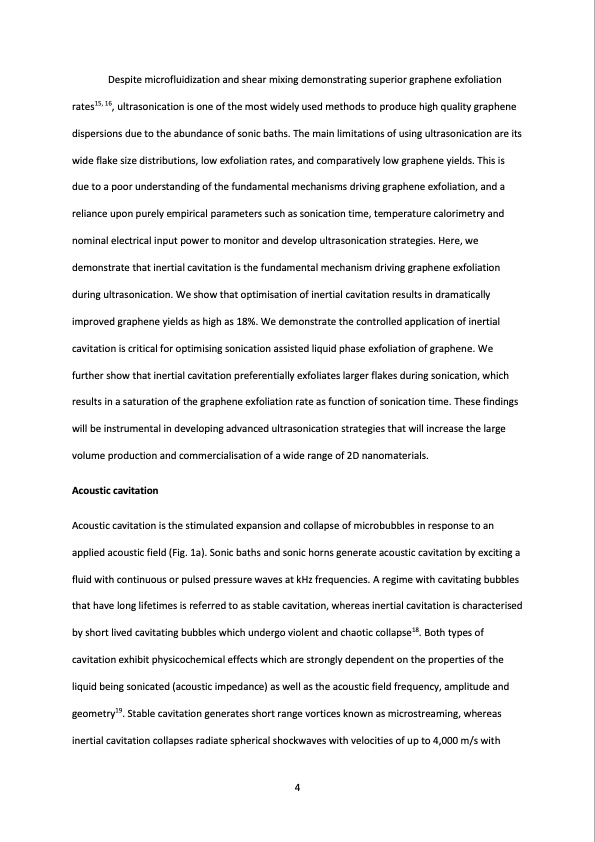PDF Publication Title:
Text from PDF Page: 004
Despite microfluidization and shear mixing demonstrating superior graphene exfoliation rates15, 16, ultrasonication is one of the most widely used methods to produce high quality graphene dispersions due to the abundance of sonic baths. The main limitations of using ultrasonication are its wide flake size distributions, low exfoliation rates, and comparatively low graphene yields. This is due to a poor understanding of the fundamental mechanisms driving graphene exfoliation, and a reliance upon purely empirical parameters such as sonication time, temperature calorimetry and nominal electrical input power to monitor and develop ultrasonication strategies. Here, we demonstrate that inertial cavitation is the fundamental mechanism driving graphene exfoliation during ultrasonication. We show that optimisation of inertial cavitation results in dramatically improved graphene yields as high as 18%. We demonstrate the controlled application of inertial cavitation is critical for optimising sonication assisted liquid phase exfoliation of graphene. We further show that inertial cavitation preferentially exfoliates larger flakes during sonication, which results in a saturation of the graphene exfoliation rate as function of sonication time. These findings will be instrumental in developing advanced ultrasonication strategies that will increase the large volume production and commercialisation of a wide range of 2D nanomaterials. Acoustic cavitation Acoustic cavitation is the stimulated expansion and collapse of microbubbles in response to an applied acoustic field (Fig. 1a). Sonic baths and sonic horns generate acoustic cavitation by exciting a fluid with continuous or pulsed pressure waves at kHz frequencies. A regime with cavitating bubbles that have long lifetimes is referred to as stable cavitation, whereas inertial cavitation is characterised by short lived cavitating bubbles which undergo violent and chaotic collapse18. Both types of cavitation exhibit physicochemical effects which are strongly dependent on the properties of the liquid being sonicated (acoustic impedance) as well as the acoustic field frequency, amplitude and geometry19. Stable cavitation generates short range vortices known as microstreaming, whereas inertial cavitation collapses radiate spherical shockwaves with velocities of up to 4,000 m/s with 4PDF Image | Cavitation Liquid Phase Exfoliation of Graphene

PDF Search Title:
Cavitation Liquid Phase Exfoliation of GrapheneOriginal File Name Searched:
1809-07630.pdfDIY PDF Search: Google It | Yahoo | Bing
Salgenx Redox Flow Battery Technology: Power up your energy storage game with Salgenx Salt Water Battery. With its advanced technology, the flow battery provides reliable, scalable, and sustainable energy storage for utility-scale projects. Upgrade to a Salgenx flow battery today and take control of your energy future.
CONTACT TEL: 608-238-6001 Email: greg@infinityturbine.com (Standard Web Page)